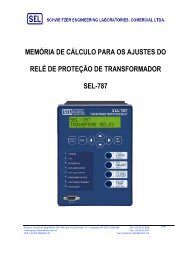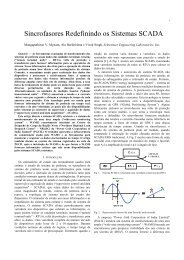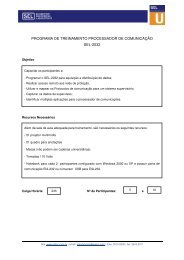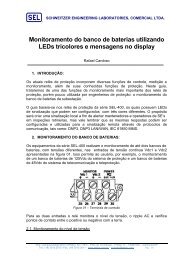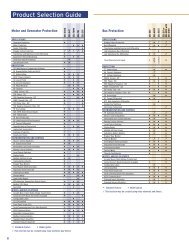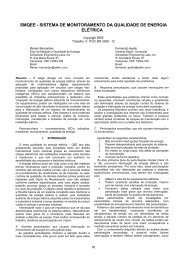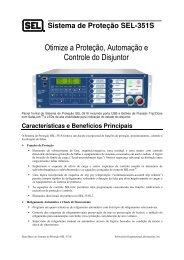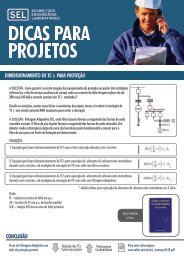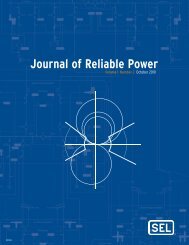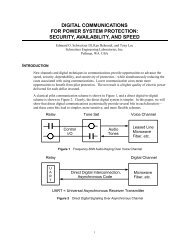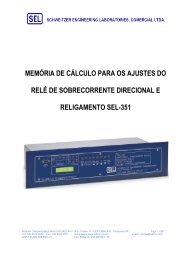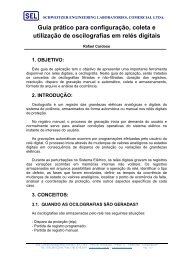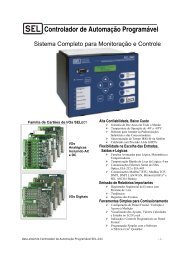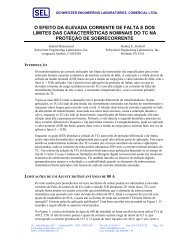Journal of Reliable Power - SEL
Journal of Reliable Power - SEL
Journal of Reliable Power - SEL
You also want an ePaper? Increase the reach of your titles
YUMPU automatically turns print PDFs into web optimized ePapers that Google loves.
12<br />
For the system in Fig. 4, Fig. 21 represents the values <strong>of</strong><br />
Real(KR) as a function <strong>of</strong> m with a constant value <strong>of</strong> Rset. The<br />
increasing values <strong>of</strong> Real(KR) indicate that the maximum<br />
detectable Rf at no load decreases as the distance to the fault<br />
increases.<br />
10<br />
9<br />
8<br />
7<br />
Real (KR)<br />
6<br />
5<br />
4<br />
Fig. 22. CT and VT error evaluation for Zone 1<br />
Fig. 23 shows the Rmax pu as a function <strong>of</strong> Zset for θL1<br />
equal to 40, 55, 70, and 75 degrees and θε equal to 2 degrees.<br />
30<br />
3<br />
2<br />
1<br />
0 0.1 0.2 0.3 0.4 0.5 0.6 0.7 0.8 0.9 1<br />
Fault Location (pu)<br />
Fig. 21. Factor Real(KR) for the system <strong>of</strong> Fig. 4<br />
Another consideration in determining the setting <strong>of</strong> the<br />
resistive coverage involves VT and CT (current transformer)<br />
errors. Reference [22] indicates that a composite angle error in<br />
the measurement θε can be assumed.<br />
A. Zone 1<br />
For a Zone 1 application, the requirement is that Zone 1<br />
never overreaches for any fault at the end <strong>of</strong> the line.<br />
Assuming that for resistive faults at the end <strong>of</strong> the line there is<br />
an angle error θε, the effective path for increasing Rf will tilt<br />
down an extra θε degrees, as shown in Fig. 22. For increasing<br />
Rf, the intersection with the Zone 1 reactive line is the<br />
indication <strong>of</strong> the maximum Rset or Rmax. Using the law <strong>of</strong><br />
sines and trigonometry, Rmax can be expressed as:<br />
sin ( θε + θ L1)<br />
Rmax = • ( 1− Zset _ pu ) • ZL1 (29)<br />
sin θε<br />
( )<br />
Equation (29) defines Rmax, the maximum secure resistive<br />
reach setting for Zone 1, taking into account CT, VT, relay<br />
measurement errors, and θε. Rmax is a function <strong>of</strong> the<br />
impedance reach setting Zset, the positive-sequence line<br />
impedance magnitude |ZL1| and angle θL1, and the total<br />
angular error in radians θε [22].<br />
Maximum Resistive Reach Setting Rmax (pu)<br />
25<br />
20<br />
15<br />
10<br />
5<br />
0<br />
0 0.1 0.2 0.3 0.4 0.5 0.6 0.7 0.8 0.9 1<br />
Impedance Reach Setting Zset (pu)<br />
Fig. 23. Maximum resistive reach setting as a function <strong>of</strong> the impedance<br />
reach due to measurement errors<br />
A typical Zone 1 impedance reach setting for short lines is<br />
70 percent. For the system in Fig. 4, Zset_zone1 is equal to<br />
1.4 ohms secondary.<br />
With Zset, |ZL1|, θL1, and θε, we can calculate Rmax using<br />
(29) or obtain the pu value Rmax_pu with respect to the total<br />
positive-sequence line impedance from Fig. 23. In this case,<br />
Rmax equals 17.17 ohms secondary, or Rmax_pu equals<br />
8.58 pu.<br />
Additionally, we need to verify that the fault current is<br />
above the maximum relay sensitivity. In this case, the residual<br />
current is 3.0 A secondary, and the relay sensitivity is 0.25 A.<br />
Therefore, the relay can see the fault at 70 percent <strong>of</strong> the line<br />
with Rf equal to 25 ohms primary.<br />
40<br />
55<br />
70<br />
85<br />
76 | <strong>Journal</strong> <strong>of</strong> <strong>Reliable</strong> <strong>Power</strong>



